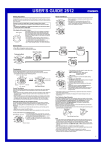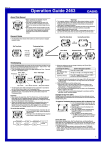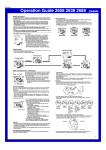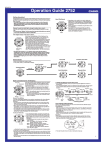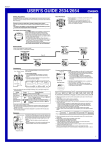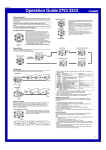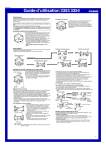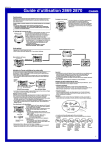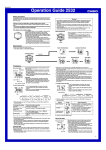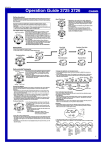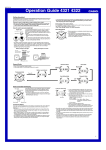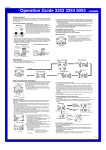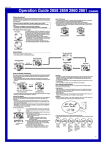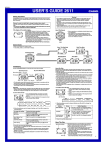Download Casio 3345 Watch User Manual
Transcript
MO0401-EA Operation Guide 3309 3345 Getting Acquainted Congratulations upon your selection of this CASIO watch. To get the most out of your purchase, be sure to carefully read this manual and keep it on hand for later reference when necessary. About This Manual • Button operations are indicated using the letters shown in the illustration. • Each section of this manual provides you with the information you need to perform operations in each mode. Further details and technical information can be found in the “Reference” section. Expose the watch to bright light to charge its battery before using it. You can use this watch even as its battery is being charged by exposure to bright light. • Be sure to read “Battery” of this manual for important information you need to know when exposing the watch to bright light. If the digital display of the watch is blank... If the Power Saving indicator ( PS) is flashing on the display, it means that the display is blank because the watch’s Power Saving function has turned it off to conserve power. Power Saving automatically turns off the display and enters a sleep state whenever your watch is left for a certain period in an area where it is dark. If the watch is kept in the dark for a longer period, the analog hands will also stop moving after a few days. • The initial factory default setting is Power Saving on. • The watch will recover from the sleep state if you move it to a well-lit area or if you press any button. • See “Power Saving Function” for more information. General Guide Battery Level Indicator World Time Mode • Press C to change from mode to mode. • In any mode, press B to illuminate the display. ▲ ▲ or Timekeeping Mode Press C. Alarm Mode ▲ ▲ ▲ ▲ Stopwatch Mode Hand Setting Mode Radio-controlled Timekeeping Hour hand Minute hand This watch receives a time calibration signal and updates its time setting accordingly. The time calibration signal includes both Standard Time and Daylight Saving Time (summer time) data. • This watch is designed to pick up the time calibration signal transmitted from Rugby, England and the signal from Mainflingen, Germany. To display the digital time and last signal screen • In the Timekeeping Mode, press A to cycle through the digital time screens as shown below. • In the Timekeeping Mode, press D to display the last signal screen. The last signal screen shows the date and time of the last successful time calibration signal reception. Date Screen ▲ Day Press A. ▲ Day of week Day of week Current Time Setting This watch automatically adjusts its time setting in accordance with a time calibration signal. You can also perform a manual procedure to set the time and date, when necessary. • The first thing you should do after purchasing this watch is to set your Home City, which is the city where you will normally use the watch. For more information, see “To set your Home City” below. • When using the watch in an area that is outside of the range of the transmitters in Rugby and Mainflingen, you need to manually adjust the time as required. See “Timekeeping” for information about manual settings. • The analog time of this watch is synchronized with the digital time. Because of this, the analog time setting is automatically adjusted whenever you change the digital setting. See “Analog Timekeeping” for more information. |||||| ||| ||| To set your Home City |||||| Transmitter indicator || || | | | | | | | | | | 1. In the Timekeeping Mode, hold down A until the transmitter indicator (AT, DCF, MSF) starts to flash, which indicates the setting screen. • If the displayed transmitter indicator shows something other than AT, use D to display AT before advancing to the next step. • The second hand will move at high speed to the 12 o’clock position, where it will stop. 2. Press C to display the city code setting screen. 3. Use D (east) and B (west) to select the city code you want to use as your Home City. • The following are the city codes for major cities in the Western Europe time zones. LON: London PAR and BER: Paris, Berlin, Milan, Rome, Amsterdam, Hamburg, Frankfurt, Vienna 4. Press A twice to exit the setting screen. | | | | | | | | | || • The first press of A displays the 12/24-hour setting screen. Pressing A again exits the setting screen. • The second hand will advance at high speed to the correct position in accordance with seconds count of the digital time, and resume normal movement from there. • Normally, your watch should show the correct time as soon as you select your Home City Code. If it does not, it should adjust automatically after the next auto receive (in the middle of the night). You can also perform manual receive or you can set the time manually. • If you are in an area that does not use Daylight Saving Time (summer time), turn off the DST setting. • See “Transmitters” for details about the transmitter indicator. ▲ A Current Time Screen A Seconds Hour : Minutes PM indicator Press D. ▲ Second hand City code ▲ Day Receiving indicator Receiving Indicator and Seconds Count Reception date 2 seconds Reception Time 2 seconds Last Signal Screen 2 seconds Time Calibration Signal Reception There are two different methods you can use to receive the time calibration signal: auto receive and manual receive. • Auto Receive With auto receive, the watch automatically picks up the time calibration signal five times a day at 0:00 a.m., 1:00 a.m., 2:00 a.m., 3:00 a.m., and 4:00 a.m. For more information, see “About Auto Receive”. • Manual Receive Manual receive lets you start time calibration signal reception with the press of a button. For more information, see “To perform manual receive”. Important! • When getting ready to receive the time calibration signal, position the watch as shown in the nearby illustration, with its 12 o’clock side facing towards a window. Make sure there are no metal objects nearby. Resin Band Metal Band • The watch should not be on its side or facing the wrong way. 1 Operation Guide 3309 3345 • Proper signal reception can be difficult or even impossible under the conditions listed below. Inside or among buildings Inside a vehicle Near household appliances, office equipment, or a mobile phone Near a Near highconstruction tension site, airport, or power lines other sources of electrical noise Among or behind mountains • Signal reception is normally better at night than during the day. • Time calibration signal reception takes from two to seven minutes, but in some cases it can take as long as 14 minutes. Take care that you do not perform any button operations or move the watch during this time. Note • To interrupt a reception and return to the Timekeeping Mode, press D. • If the reception is unsuccessful, the message ERR appears on the display for about one or two minutes. After that, the watch returns to the Timekeeping Mode. • You can also change from the last signal or ERR screen to the normal timekeeping screen by pressing D. ||| To turn auto receive on and off 1. In the Timekeeping Mode, hold down A until the transmitter indicator starts to flash, which indicates the setting screen. On/off status • The second hand will move at high speed to the 12 o’clock position, where it will stop. 2. Press C three times to move the flashing to the auto | | | | receive on/off setting. | | 3. Press D to toggle auto receive on (ON) and off (OF). • If the current Home City setting is a city code that does not support auto receive, “--” appears in place of the on/off indicator. This means you cannot turn auto receive on or off. 4. Press A twice to exit the setting screen. |||||| Rugby 500 kilometers • The second hand will advance at high speed to the correct position in accordance with the digital time seconds count, and resume normal movement from there. • For information about city codes that support signal reception, see “To set your Home City”. Mainflingen • This watch is designed to receive the time calibration signal transmitted from Rugby, England and the signal from Mainflingen, Germany. Signal reception is possible within the area represented by a circle with a radius of about 1,000 kilometers. • At distances further than about 500 kilometers from a transmitter, signal reception may not be possible during certain times of year or times of day. Radio interference may also cause problems with reception. • See the information under “Signal Reception Troubleshooting” if you experience problems with time calibration signal reception. About Auto Receive When auto receive is turned on, the watch automatically starts to receive the time calibration signal when the time in the Timekeeping Mode reaches 0:00 a.m., 1:00 a.m., 2:00 a.m., 3:00 a.m., and 4:00 a.m. each day (calibration times). The watch will also perform an additional auto receive at 5:00 a.m. if none of the regularly scheduled auto receive are successful. Note • Auto receive is performed only if the watch is in the Timekeeping Mode or World Time Mode when one of the calibration times is reached. It is not performed if a calibration time is reached while an alarm is sounding, or while you are configuring settings (while settings are flashing on the display). • When a reception starts, the second hand will move at high speed to the 12 o’clock position where it will stop until the reception is complete. • Auto receipt of the calibration signal is designed to be performed early in the morning, while you sleep (provided that the Timekeeping Mode time is set correctly). Before going to bed for the night, remove the watch from your wrist, and put it in a location where it can easily receive the signal. • When auto receive is turned on, the watch receives the calibration signal for two to seven minutes everyday when the time in the Timekeeping Mode reaches each of the five calibration times. Do not perform any button operation within seven minutes before or after any of the five calibration times. Doing so can interfere with correct calibration. • Remember that reception of the calibration signal depends on the time kept in the digital display. The reception will be performed whenever the display shows one of the five calibration times, regardless of whether or not the displayed time is actually the correct time. • When two, three, four, or five receptions are successful, the watch uses the data of the last reception for calibration. When only one reception is successful, the watch uses the data of the successful reception. Signal Reception Troubleshooting Check the following points whenever you experience problems with signal reception. Problem Cannot perform manual receive. Auto receive is turned on, but the Level 4 receiving indicator does not appear on the Timekeeping Mode display. Time setting is incorrect following signal reception. Probable Cause What you should do • The watch is not in the Timekeeping • Enter the Timekeeping Mode and Mode. try again. • Your current Home City is not one of • Select BER, PAR, or LON as your Home City. the following city codes: BER, PAR, or • Select the appropriate transmitter LON. setting for your current location. • You changed the time setting • Select the appropriate transmitter manually. setting for your current location. • The watch was not in the Timekeeping • Perform manual receive or wait or World Time Mode, or you were until the next auto receive is performing some button operation performed. during auto receive. • Check to make sure the watch is • Even if reception is successful, the in a location where it can receive Level 4 receiving indicator the signal. disappears every day at 3 a.m. • Time data (hour, minutes, seconds) only was received during the last reception. The Level 4 receiving indicator appears only when time data and date data (year, month, day) are both received. • If the time is one hour off, the DST setting may be incorrect. • The Home City code setting is not correct for the area where you are using the watch. Receiving indicator World Time City Code Current time in the selected city code Strong (Level 4) • Even in an area where signal strength is strong, it takes about 10 seconds for signal reception to stabilize enough for the receiving indicator to indicate signal strength. • Use the receiving indicator as a guide for checking signal strength and for finding the best location for the watch during signal reception. • The Level 4 receiving indicator appears on the Timekeeping Mode’s Receiving Indicator and Seconds Count screen only. The Level 4 receiving indicator is not displayed if signal reception was unsuccessful or after manual adjustment of the current time setting. • The Level 4 receiving indicator indicates that at least one of the five calibration signal reception was successful. Note, however, that the Level 4 receiving indicator is cleared from the display at 3:00 a.m. each day. ||| ||| To perform manual receive 1. Place the watch on a stable surface so its top (12 o’clock side) is facing towards a window. Receiving indicator 2. In the Timekeeping Mode, hold down D for about two seconds until the watch beeps. 3. Release D and RC flashes to indicate that signal reception has started. | | | || | • When a reception starts, the second hand will move at high speed to the 12 o’clock position where it will stop until the reception is complete. • Change the DST setting to Auto DST. • Select the correct Home City code. • For further information, see “Important!” under “Time Calibration Signal Reception” and “Radio-controlled Timekeeping Precautions”. About the Receiving Indicator The receiving indicator shows the strength of the calibration signal being received. For best reception, be sure to keep the watch in a location where signal strength is strongest. Weak (Level 1) ||| 1,000 kilometers • Time calibration signal reception normally takes from two to seven minutes, but in some cases it can take as long as 14 minutes. Take care that you do not perform any button operations or move the watch during this time. • After signal reception is complete, the display of the watch changes to the last signal screen. The World Time Mode digitally displays the current time in 30 cities (29 time zones) around the world. • Pressing A in the World Time Mode causes the applicable city code to appear on the digital display for about two seconds. • If the current time shown for a city is wrong, check your Home City time settings and make the necessary changes. • The watch will perform a signal reception even if it is in the World Time Mode when a calibration time is reached. If this happens, the World Time Mode time settings will be adjusted in accordance with the Timekeeping Mode’s Home City time. • All of the operations in this section are performed in the World Time Mode, which you enter by pressing C. To view the time in another city While in the World Time Mode, press D to scroll through the city codes (time zones). • For full information on city codes, see the “City Code Table”. To toggle a city code time between Standard Time and Daylight Saving Time 1. In the World Time Mode, use D to display the city code (time zone) whose Standard Time/Daylight Saving Time setting you want to change. • Pressing A in the World Time Mode causes the applicable city code to appear on the digital display for about two seconds. 2. Hold down A to toggle Daylight Saving Time (DST indicator displayed) and Standard Time (DST indicator DST indicator not displayed). • Note that you cannot use the World Time Mode to change the DST setting of the Home City code you currently have selected in the Timekeeping Mode. See “To change the Daylight Saving Time (summer time) setting” for information about turning the Home City code DST setting on and off. • The DST indicator will appear on the display whenever you display a city code for which Daylight Saving Time is turned on. • Note that you cannot switch between Standard Time and Daylight Saving Time while GMT is selected as the city code. • Note that the DST/Standard Time setting affects only the currently displayed city code. Other city codes are not affected. 2 |||||| Operation Guide 3309 3345 Alarms Battery On/Off status You can set three independent Daily Alarms. When an alarm is turned on, the alarm tone sounds when the alarm time is reached. You can also turn on an Hourly Time Signal that causes the watch to beep twice every hour on the hour. • The alarm and Hourly Time Signal operate in accordance with the current digital time. • The alarm number (AL1 though AL3) indicates an alarm screen. SIG appears in place of the alarm number when the Hourly Time Signal screen is shown. Alternate at • All of the operations in this section are performed in the two-second Alarm Mode, which you enter by pressing C. Alarm Mode number indicator interval Alarm time (Hour : Minutes) To set an alarm time 1. In the Alarm Mode, press D to select the alarm whose time you want to set. AL1 AL2 AL3 SIG 2. Hold down A until the hour setting of the alarm time starts to flash, which indicates the setting screen. • This automatically turns on the alarm. 3. Press C to move the flashing between the hour and minute settings. 4. While a setting is flashing, use D (+) and B (–) to change it. • When setting the alarm time using the 12-hour format, take care to set the time correctly as a.m. (no indicator) or p.m. (P indicator). • If you have 24-hour timekeeping selected in the Timekeeping Mode, the alarm time is also displayed in 24-hour format. 5. Press A to exit the setting screen. Alarm Operation The alarm sounds in all modes at the preset time for about 10 seconds, or until you stop it by pressing any button. To test the alarm In the Alarm Mode, hold down D to sound the alarm. This watch is equipped with a solar cell and a rechargeable battery (secondary battery) that is charged by the electrical power produced by the solar cell. The illustration shown below shows how you should position the watch for charging. Example: Orient the watch so its face is pointing at a light source. • The illustration shows how to position a watch with a resin band. • Note that charging efficiency drops when any part of the solar cell is blocked by clothing, etc. • Normally, you should try to keep the watch outside of your sleeve as much as possible. Charging is significantly reduced if the face is only partially covered. Solar cell Important! • Storing the watch for long periods in an area where there is no light or wearing it in such a way that it is blocked from exposure to light can cause rechargeable battery power to run down. Make sure that the watch is normally exposed to bright light whenever possible. • Normally, the rechargeable battery should not need replacement, but after very long use over a number of years, the rechargeable battery may lose its ability to achieve a full charge. Should you notice problems with getting the rechargeable battery to a full charge, contact your dealer or CASIO distributor about having it replaced. • The rechargeable battery should be replaced with a CASIO-specified CTL1616 battery only. Other rechargeable batteries can cause damage to the watch. • All data stored in memory is deleted, and the current time and all other settings return to their initial factory defaults whenever battery level drops to Level 4 and when you have the battery replaced. • Turn on the watch’s Power Saving function and keep it in an area normally exposed to bright light when storing it for long periods. This helps to keep the rechargeable battery from going dead. To check the current battery level In the Timekeeping Mode, press C once to display the battery level indicator. • The battery level indicator shows the battery level either as HI (Level 1) or MID (Level 2). • If the battery level drops below Level 2 (MID), a charge soon alert (Level 3) is displayed in all modes. Battery level indicator To turn an alarm and the Hourly Time Signal on and off 1. In the Alarm Mode, press D to select an alarm or the Hourly Time Signal. 2. When the alarm or the Hourly Time Signal you want to set is selected, press A to turn it on and off. or Stopwatch Elapsed time (Minutes : Seconds) 1 All functions enabled. 3 | | | | | | | (Minutes : Seconds) 4 ||||| ||||| (Charge Soon Alert) 1/100 second || || Minutes Seconds Function Status All functions enabled. 2 Split Time Screen Split time Split indicator Battery Level Indicator | | More than one minute 1/100 second Level | | The stopwatch lets you measure elapsed time, split times, and two finishes. • The display range of the stopwatch is 99 minutes, 59.99 seconds. • The 1/100-second value appears while the elapsed time operation is stopped or while a split time is frozen on the display. Elapsed Time Screen 1/100 Seconds second Auto and manual receive, alarm, hourly time signal, illumination, and display are disabled. Though the hands of the watch do not move, time continues to be kept internally. All functions, including timekeeping, disabled. ||| • The stopwatch continues to run, restarting from zero after it reaches its limit, until you stop it. • Exiting the Stopwatch Mode while a split time is frozen on the display clears the split time and returns to elapsed time measurement. • The stopwatch measurement operation continues even if you exit the Stopwatch Mode. • All of the operations in this section are performed in the Stopwatch Mode, which you enter by pressing C. • The flashing charge indicator ( C ) at Level 3 tells you that battery power is very low, and that exposure to bright light for charging is required as soon as possible. • At Level 4, all functions are disabled and settings return to their initial factory defaults. Functions are enabled once again after the rechargeable battery is charged, but you need to set the time and date, after the battery reaches Level 2 from Level 4. • Leaving the watch in direct sunlight or some other very strong light source can cause the battery level indicator to temporarily show a reading that is higher than the actual battery level. The correct battery level indicator should appear after a few minutes. • If you use the light or alarms a number of times during a short period, the recover indicator ( R ) appears on the display and the following operations become disabled until battery power recovers. Illumination Beeper tone Coordination between digital and analog timekeeping Time calibration signal reception To measure times with the stopwatch Elapsed Time D Start ➤D Stop ➤D Re-start ➤D Stop ➤A Clear ➤A Split ➤A Split release ➤D Stop ➤A Clear ➤A Split ➤D Stop ➤A Split release ➤A Clear Split Time D Start Recover indicator After some time, battery power will recover and the recover indicator will disappear, indicating that the above functions are enabled again. Two Finishes D Start First runner finishes. Display time of first runner. Second runner finishes. Display time of second runner. Illumination An LED (light-emitting diode) and a light guide panel illuminate the digital display for easy reading in the dark. • See “Illumination Precautions” for other important information. To illuminate the display In any mode, press B to illuminate the display. • You can specify 1.5 seconds or 2.5 seconds as the illumination duration. See “To set the current digital time and date manually” for more information. Charging Precautions Certain charging conditions can cause the watch to become very hot. Avoid leaving the watch in the areas described below whenever charging its rechargeable battery. Also note that allowing the watch to become very hot can cause its liquid crystal display to black out. The appearance of the LCD should become normal again when the watch returns to a lower temperature. Warning! Leaving the watch in bright light to charge its rechargeable battery can cause it to become quite hot. Take care when handling the watch to avoid burn injury. The watch can become particularly hot when exposed to the following conditions for long periods. • On the dashboard of a car parked in direct sunlight • Too close to an incandescent lamp • Under direct sunlight 3 Operation Guide 3309 3345 Charging Guide After a full charge, timekeeping remains enabled for up to about 5 months. • The following table shows the amount of time the watch needs to be exposed to light each day in order to generate enough power for normal daily operations. 3. When the setting you want to change is flashing, use B and/or D to change it as described below. Transmitter/City Settings Screen: Exposure Level (Brightness) Approximate Exposure Time Outdoor Sunlight (50,000 lux) 5 minutes Sunlight Through a Window (10,000 lux) 24 minutes Daylight Through a Window on a Cloudy Day (5,000 lux) 48 minutes Indoor Fluorescent Lighting (500 lux) 8 hours • Since these are the specs, we can include all the technical details. • 1 illumination operation (1.5 seconds) per day • 10 seconds of alarm operation per day • 5 times calibration reception per day • Stable operation is promoted by frequent charging. Level 3 Screen: Level 2 Level 1 10 hours 1 hour ▲ ▲ ▲ ▲ Outdoor Sunlight (50,000 lux) Timekeeping Use the Timekeeping Mode to set and view the current time and date. This section also explains how to manually set the current date and time. • When setting the time, you can also configure settings for the illumination duration, the 12/24-hour format, and power saving on/off. • All of the operations in this section are performed in the Timekeeping Mode, which you can enter by pressing C. ▲ Day Press A. ▲ ▲ Day of week ▲ Receiving indicator Receiving Indicator and Seconds Count A Current Time Screen A Seconds ▲ Reception date 2 seconds Reception Time 2 seconds Last Signal Screen 2 seconds Setting the Digital Time and Date Manually Make sure you select your Home City code before you change the current time and date settings. World Time Mode times are all displayed in accordance with the Timekeeping Mode settings. Because of this, World Time Mode times will not be correct if you do not select the proper Home City code before setting the time and date in the Timekeeping Mode. ||| ||| To set the current digital time and date manually 1. In the Timekeeping Mode, hold down A until the transmitter indicator starts to flash, which indicates the setting screen. |||||| • The second hand will move at high speed to the 12 o’clock position, where it will stop. 2. Use A or C to move the flashing in the sequence shown below to select other settings. |||||| Transmitter indicator Press C. Transmitter/ City Settings DST Auto Receive Seconds Hour Minutes Day Month Year City Code Transmitter A Time/Date Settings 12/24-Hour Format Power Saving Press D. To do this: Do this: Toggle between 12-hour ( ) and 24-hour ( ) timekeeping Reset the seconds to Toggle the illumination duration setting between 1.5 second ( ) and 2.5 seconds ( ) Change the hour or minutes Press D. Change the year Use D (+) and B (–). Change the month or day Use D (+) and B (–). Toggle Power Saving on (ON) and off (OF) Press D. Press D. Press B. Use D (+) and B (–). • For information about settings other than the time and date, see the following. Illumination duration: Illumination Power Saving: Power Saving Function 4. Use A to exit the setting screen. • If a Transmitter/City Setting screen is displayed, press A twice. • If a Time/Date Setting screen is displayed, press A once. • The second hand will advance at high speed to the correct position in accordance with the digital time seconds count, and resume normal movement from there. • When you exit the setting screen, the analog hands are adjusted automatically to match the digital time. See “Analog Timekeeping” for more information. Note • See “Transmitters” for more information. • Auto DST (A) can be selected only while BER, PAR, LON, or ATH is selected as the Home City code. For more information, see “Daylight Saving Time (DST)” below. • The auto receive setting is used for time calibration signal reception only. See “About Auto Receive” for details. Daylight Saving Time (summer time) advances the time setting by one hour from Standard Time. Remember that not all countries or even local areas use Daylight Saving Time. The time calibration signals transmitted from Rugby and Mainflingen includes both Standard Time and DST data. When the Auto DST setting is turned on, the watch switches between Standard Time and DST (summer time) automatically in accordance with the received time signal. • The default DST setting is Auto DST (A) whenever you select BER, PAR, LON, or ATH as your Home City code. • If you experience problems receiving the time calibration signal in your area, it is probably best to switch between Standard Time and Daylight Saving Time (summer time) manually. To change the Daylight Saving Time (summer time) setting 1. In the Timekeeping Mode, hold down A until the transmitter indicator starts to flash, which indicates the setting screen. 2. Press C twice and the DST setting screen appears. 3. Use D to cycle through the DST settings in the sequence shown below. Auto DST (A) DST off (OF) DST on (ON) 4. When the setting you want is selected, press A twice to exit the setting screen. • The DST indicator appears on the display to indicate that Daylight Saving Time is turned on. Analog Timekeeping The analog time of this watch is synchronized with the digital time. The analog time setting is adjusted automatically whenever you change the digital time. / Press A. C Use D (east) and B (west). Daylight Saving Time (DST) Hour : Minutes PM indicator Press D. Press D. 5 hours Sunlight Through a Window 4 hours 48 hours 22 hours (10,000 lux) Daylight Through a Window 8 hours 99 hours 46 hours on a Cloudy Day (5,000 lux) Indoor Fluorescent Lighting 76 hours ––– (500 lux) • The above exposure time values are all for reference only. Actual required exposure times depend on lighting conditions. Date Screen Toggle between Daylight Saving Time (ON) , Standard Time (OF), or Auto DST (A) Toggle between auto receive on (ON) and off (OF) Time/Date Settings Approximate Exposure Time Level 4 Do this: Use D. • See “City Code Table” for a complete list of available city codes. Recovery Times The table below shows the amount exposure that is required to take the battery from one level to the next. Exposure Level (Brightness) To do this: Change the transmitter setting (AT, MSF, or DCF) Change the city code C Note • The hands for the analog timepiece move to adjust to a new setting whenever any of the following occurs. When you change the digital time setting manually When the digital time setting is changed by time calibration signal reception When you change the Home City code and/or DST setting • If the analog time does not match the digital time for any reason, use the procedure described under “To adjust the analog time” to match the analog setting to the digital setting. • Whenever you need to adjust both the digital and the analog time settings manually, make sure you adjust the digital setting first. • Depending on how much the hands have to move in order to adjust to the digital time, it may take some time before they stop moving. 4 Operation Guide 3309 3345 To adjust the analog time 1. In the Timekeeping Mode, press C five times to enter the Hand Setting Mode. 2. Hold down A until starts to flash, which indicates the setting screen. • The second hand will move at high speed to the 12 o’clock position, where it will stop. 3. If the second hand is not pointing precisely at 12 o’clock at this time, use D to adjust its position. • Each press of D causes the second hand to advance by one second. || || || |||||||| |||||||||| 4. Press C. This will cause the time on the digital display to flash, which indicates that adjustment of hour and minute hands is selected. 5. Use D and B to adjust the analog setting as described below. When you want to do this: Move the hand setting forward 20 seconds Move the hand setting back 20 seconds Move the hand setting a short way forward at high speed Move the hand setting a short way back at high speed Move the hand setting a long way forward at high speed Move the hand setting a long way back at high speed Perform this button operation: • Press D. • Press B. • Hold down D. • Release D when the hands reach the setting you want. • Hold down B. • Release B when the hands reach the setting you want. • While holding down D to move the hands at high-speed, press B to lock the high-speed hand movement. • To stop the hand movement, press any button. • Hand movement stops automatically if the hour hand makes one full (12-hour) revolution. • While holding down B to move the hands at high-speed, press D to lock the high-speed hand movement. • To stop the hand movement, press any button. • Hand movement stops automatically if the hour hand makes one full (12-hour) revolution. 6. Press A to exit the setting screen. • The minute hand will be adjusted slightly to match the seconds when you exit the setting screen. • To return to the Timekeeping Mode, press C. Reference This section contains more detailed and technical information about watch operation. It also contains important precautions and notes about the various features and functions of this watch. Power Saving Function When turned on, the Power Saving function automatically enters a sleep state whenever the watch is left in an area where lighting is dim (less than about 30 lux). The following shows how watch functions are affected when left in a dark place while in the sleep state. Power Saving indicator Approximate Period in sleep state 3 to 4 days 8 days or more • If you leave the watch in the Alarm or Hand Setting Mode, or with the Battery Level Indicator (HI or MID) displayed for two or three minutes without performing any operation, it automatically returns to the Timekeeping Mode. • If you leave the watch with a flashing setting on the display for two or three minutes without performing any operation, the watch automatically exits the setting screen. Scrolling The B and D buttons are used in various modes and setting screens to scroll through data on the display. In most cases, holding down these buttons during a scroll operation scrolls through the data at high speed. Initial Screens When you enter the World Time or Alarm Mode, the data you were viewing when you last exited the mode appears first. Radio-controlled Timekeeping Precautions • Strong electrostatic charge can result in the wrong time being set. • Even when the watch is within the reception range of the transmitter, signal reception will be impossible if the signal is blocked by mountains or other geological formations between the watch and signal source. • Signal reception is affected by weather, atmospheric conditions, and seasonal changes. • The time calibration signal bounces off the ionosphere. Because of this, such factors as changes in the reflectivity of the ionosphere, as well as movement of the ionosphere to higher altitudes due to seasonal atmospheric changes or the time of day may change the reception range of the signal and make reception temporarily impossible. • Even if the time calibration signal is received properly, certain conditions can cause the time setting to be off by up to one second. • The current time setting in accordance with the time calibration signal takes priority over any time settings you make manually. • The watch is designed to automatically update the date and day of the week for the period January 1, 2000 to December 31, 2099. Setting of the date by the time calibration signal cannot be performed starting from January 1, 2100. • This watch can receive signals that differentiate between leap years and non-leap years. • Though this watch is designed to receive both time data (hour, minutes, seconds) and date data (year, month, day), certain signal conditions can limit reception to time data only. • Normally, the signal reception date shown by the last signal screen is the date data included in the received time calibration signal. When only time data is received, however, the last signal screen shows the date as kept in the Timekeeping Mode at the time of signal reception. • If you are in an area where proper time calibration signal reception is impossible, the watch keeps time within ±15 seconds a month at normal temperature. • If you have problems with proper time calibration signal reception or if the time setting is wrong after signal reception, check your transmitter, current city code, DST (summer time), and auto receive settings. The following are the initial factory defaults for these settings. Setting Initial Factory Default AT Transmitter City code LON (London) (Module 3309) BER (Berlin) (Module 3345) DST (summer time) (Auto switching) Auto receive (Auto receive) Transmitters This watch is designed to receive the time calibration signal transmitted from Rugby, England and the signal from Mainflingen, Germany. You can select either one of the transmitters, or you can configure the watch to automatically select the transmitter that has the strongest signal. • The following explains how the watch determines which transmitter it should check first while the watch is configured for auto transmitter search (AT). Module 3309 Functions • LCD off • Alarm, hourly time signal, analog timekeeping and auto receive enabled • LCD off, alarm and hourly time signal disabled • Analog timekeeping stopped at 12 o’clock • Auto receive disabled The sleep state is indicated by a blank screen with the Power Saving indicator ( PS) flashing on it. • Wearing the watch inside the sleeve of clothing can cause it to enter the sleep state. To recover from the sleep state Perform any one of the following operations. • Move the watch to a well-lit area. • Press any button. ||| To turn Power Saving on and off 1. In the Timekeeping Mode, hold down A until the transmitter indicator starts to flash, which indicates the setting screen. | | | || | • The second hand will move at high speed to the 12 o’clock position, where it will stop. 2. Press A again. 3. Press C seven times until the Power Saving on/off On/Off status screen appears. 4. Press D to toggle Power Saving on (ON) and off (OF). 5. Press A to exit the setting screen. ||| Auto Return Features In this case: The watch does this: The first signal auto search operation 1. Checks the Rugby signal first. after factory default settings are in effect, 2. If the Rugby signal cannot be received, or after the city code has been changed checks the Mainflingen signal. Any case other than the above. 1. Checks the last successfully received signal first. 2. If the last successfully received signal cannot be received, checks the other signal. Module 3345 In this case: The watch does this: The first signal auto search operation 1. Checks the Mainflingen signal first. after factory default settings are in effect, 2. If the Mainflingen signal cannot be or after the city code has been changed received, checks the Rugby signal. Any case other than the above. 1. Checks the last successfully received signal first. 2. If the last successfully received signal cannot be received, checks the other signal. • Since the watch checks signals from both transmitters when AT is selected as the transmitter setting, signal reception can take as long as 14 minutes. 3309 3345 • To find out the module number of your watch, look at its back cover. The Module number (3309 or 3345) is engraved inside the box on the back cover. |||||| • The second hand will advance at high speed to the correct position in accordance with the digital time seconds count, and resume normal movement from there. • The Power Saving indicator ( PS) is on the display in all modes while the Power Saving is turned on. 5 Operation Guide 3309 3345 |||||| ||| ||| To select a transmitter 1. In the Timekeeping Mode, hold down A until the transmitter indicator starts to flash, which indicates the setting screen. • The second hand will move at high speed to the 12 o’clock position, where it will stop. 2. Use D to scroll through available transmitter settings until the one you want to select is displayed. |||||| Transmitter indicator To set up the watch to do this: Select this transmitter setting: Automatically select the Rugby or Mainflingen signal AT Receive the Mainflingen signal DCF Receive the Rugby signal MSF • Note that --- appears in place of the transmitter indicator when any city code besides LON, PAR, BER, or ATH is selected as the Home City code. This indicates that you cannot specify a transmitter. 3. Press A twice to exit the setting screen. • Reception can take up to 14 minutes when the AT option is selected. • The second hand will advance at high speed to the correct position in accordance with seconds count of the digital time, and resume normal movement from there. Timekeeping • Resetting the seconds to 00 while the current count is in the range of 30 to 59 causes the minutes to be increased by 1. In the range of 00 to 29, the seconds are reset to 00 without changing the minutes. • The day of the week is automatically displayed in accordance with the date (year, month, and day) settings. • The year can be set in the range of 2000 to 2099. • The watch’s built-in full automatic calendar makes allowances for different month lengths and leap years. Once you set the date, there should be no reason to change it except after you have the watch’s battery replaced or when battery level drops to Level 4. • The current time for all city codes in the Timekeeping Mode and World Time Mode is calculated in accordance with the Greenwich Mean Time (GMT) differential for each city, based on your Home City time setting. • GMT differential is calculated by this watch based on Universal Time Coordinated (UTC*) data. * UTC is the world-wide scientific standard of timekeeping. It is based upon carefully maintained atomic (cesium) clocks that keep time accurately to within microseconds. Leap seconds are added or subtracted as necessary to keep UTC in sync with the Earth’s rotation. The reference point for UTC is Greenwich, England. 12-hour/24-hour Timekeeping Formats The 12-hour/24-hour timekeeping format you select in the Timekeeping Mode is also applied in all other modes. • With the 12-hour format, the P (PM) indicator appears on the display for times in the range of noon to 11:59 p.m. and no indicator appears for times in the range of midnight to 11:59 a.m. • With the 24-hour format, times are displayed in the range of 0:00 to 23:59 without any indicator. Illumination Precautions • The illumination provided by the light may be hard to see when viewed under direct sunlight. • Illumination automatically turns off whenever an alarm sounds. • Frequent use of illumination shortens the battery operating time. City Code Table City Code City GMT Differential ––– HNL ANC Honolulu Anchorage –11.0 –10.0 –09.0 LAX Los Angeles –08.0 DEN Denver –07.0 CHI Chicago –06.0 NYC New York –05.0 CCS RIO ––– ––– GMT LON PAR BER ATH CAI JRS JED THR DXB KBL KHI DEL DAC RGN BKK Caracas Rio De Janeiro –04.0 –03.0 –02.0 –01.0 London Paris Berlin Athens Cairo Jerusalem Jeddah Tehran Dubai Kabul Karachi Delhi Dhaka Yangon Bangkok +00.0 HKG Hong Kong +08.0 SEL TYO ADL SYD NOU WLG Seoul Tokyo Adelaide Sydney Noumea Wellington +01.0 +02.0 +03.0 +03.5 +04.0 +04.5 +05.0 +05.5 +06.0 +06.5 +07.0 +09.0 +09.5 +10.0 +11.0 +12.0 Other major cities in same time zone Pago Pago Papeete Nome San Francisco, Las Vegas, Vancouver, Seattle/Tacoma, Dawson City El Paso, Edmonton Houston, Dallas/Ft. Worth, New Orleans, Mexico City, Winnipeg Montreal, Detroit, Miami, Boston, Panama City, Havana, Lima, Bogota La Paz, Santiago, Pt. Of Spain Sao Paulo, Buenos Aires, Brasilia, Montevideo Praia Dublin, Lisbon, Casablanca, Dakar, Abidjan Milan, Rome, Madrid, Amsterdam, Algiers, Hamburg, Frankfurt, Vienna, Stockholm Helsinki, Istanbul, Beirut, Damascus, Cape Town Kuwait, Riyadh, Aden, Addis Ababa, Nairobi, Moscow Shiraz Abu Dhabi, Muscat Male Mumbai, Kolkata Colombo Jakarta, Phnom Penh, Hanoi, Vientiane Singapore, Kuala Lumpur, Beijing, Taipei, Manila, Perth, Ulaanbaatar Pyongyang Darwin Melbourne, Guam, Rabaul Pt. Vila Christchurch, Nadi, Nauru Is. • Based on data as of June 2003. 6






